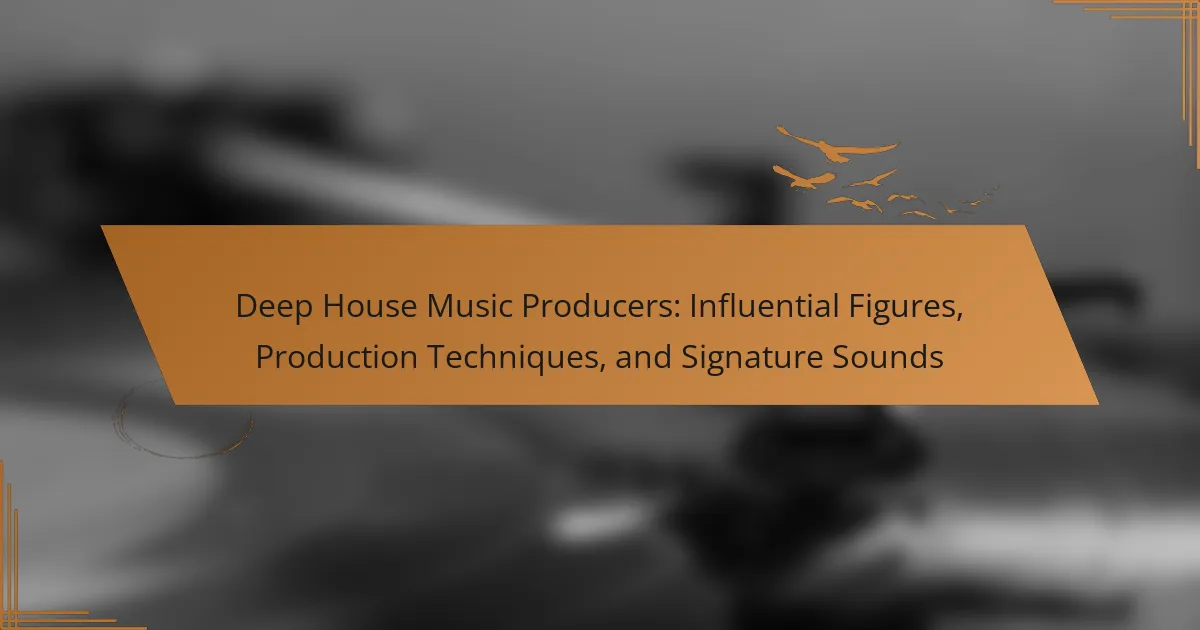Deep house music is a subgenre of house music known for its soulful melodies and complex harmonies. Originating in the 1980s, primarily in Chicago and later in Europe, deep house combines elements of jazz, funk, and soul to create a smooth, atmospheric sound characterized by slower tempos and rich basslines. This genre has significantly influenced the evolution of electronic dance music, promoting inclusivity and community through dance and social gatherings. Key production techniques such as sampling, layering, and the use of effects contribute to its distinctive sound, which features intricate chord progressions and soft, ethereal vocals. The article will explore influential deep house music producers, their signature sounds, and the production techniques that define the genre.

What is Deep House Music and its Cultural Significance?
Deep house music is a subgenre of house music characterized by its soulful melodies and complex harmonies. It emerged in the 1980s, primarily in Chicago and later in Europe. The genre blends elements of jazz, funk, and soul, creating a smooth, laid-back sound. Deep house typically features slower tempos and a focus on atmospheric soundscapes.
Culturally, deep house music has played a significant role in the evolution of electronic dance music. It has influenced various artists and genres, promoting inclusivity and diversity within the music scene. The genre often emphasizes emotional expression, connecting listeners through its rich, melodic structures.
Deep house also fosters community through dance and social gatherings, contributing to the development of club culture. The genre’s significance is evident in its lasting impact on music festivals and underground scenes worldwide.
How did Deep House Music evolve over the years?
Deep House Music evolved significantly from its origins in the 1980s. It began as a subgenre of house music, characterized by its soulful vocals and jazzy elements. Early pioneers like Larry Heard and Frankie Knuckles shaped its sound. In the 1990s, Deep House gained popularity in clubs, incorporating elements from funk and disco. The genre saw a resurgence in the 2000s with artists like Miguel Migs and Kerri Chandler. Digital production techniques enhanced its accessibility and creativity. By the 2010s, Deep House blended with mainstream electronic music, leading to broader appeal. Today, it continues to influence various genres and remains a staple in dance music culture.
What are the key historical milestones in the development of Deep House Music?
Deep House Music emerged in the 1980s, blending elements of Chicago house and jazz. In 1985, the release of “Can You Feel It” by Mr. Fingers marked a pivotal moment. This track introduced deeper, soulful sounds that defined the genre. The 1990s saw the rise of labels like Strictly Rhythm and Defected Records, promoting deep house artists. In 1992, the track “Deep Burnt” by Pepe Bradock further solidified the genre’s identity. The 2000s brought a resurgence, with artists like Frankie Knuckles and Louie Vega gaining prominence. By the late 2010s, deep house became mainstream, influencing pop music and festivals globally. These milestones illustrate the genre’s evolution and cultural impact.
How has Deep House Music influenced other genres?
Deep House Music has significantly influenced genres like pop, hip-hop, and techno. Its smooth, melodic elements have been incorporated into mainstream pop music. Artists like Drake and Dua Lipa have used deep house beats in their tracks. The genre’s emphasis on groove and rhythm has also impacted hip-hop production. Producers often sample deep house tracks for their laid-back vibes. Additionally, techno has adopted deep house’s atmospheric qualities, creating sub-genres like deep techno. This blending of styles showcases deep house’s versatility and enduring appeal.
Who are the most influential Deep House Music producers?
The most influential Deep House Music producers include Larry Heard, Kerri Chandler, and Frankie Knuckles. Larry Heard, known as Mr. Fingers, pioneered the genre in the 1980s with tracks like “Can You Feel It.” Kerri Chandler is celebrated for his soulful approach and innovative use of rhythm. Frankie Knuckles, often referred to as the “Godfather of House,” significantly shaped the sound of deep house with his remixes and original productions. These producers have left a lasting impact on the genre, influencing countless artists and shaping Deep House’s evolution. Their contributions have established foundational sounds that define Deep House music today.
What contributions did pioneers like Frankie Knuckles and Larry Heard make?
Frankie Knuckles and Larry Heard significantly shaped the deep house music genre. Frankie Knuckles, known as the “Godfather of House,” pioneered the sound by blending disco, soul, and funk elements. He was instrumental in creating the Chicago house scene in the 1980s, particularly through his work at the Warehouse club. His track “Your Love,” co-produced with Jamie Principle, became a classic, showcasing his innovative use of synthesizers and drum machines.
Larry Heard, also known as Mr. Fingers, contributed to the genre with his distinct sound that emphasized melody and atmosphere. His track “Can You Feel It” is a seminal piece that defined deep house’s emotional depth. Heard’s use of lush chords and intricate basslines set a template for future producers in the genre. Both artists’ contributions laid the foundation for deep house music, influencing countless musicians and producers worldwide.
How do contemporary producers like Disclosure and Jamie Jones shape the genre?
Contemporary producers like Disclosure and Jamie Jones significantly shape the deep house genre through innovative production techniques and unique soundscapes. Disclosure is known for blending electronic elements with soulful vocals, creating accessible tracks that appeal to mainstream audiences. Their hit “Latch” exemplifies this fusion, showcasing catchy melodies and polished production. Jamie Jones, on the other hand, emphasizes a more underground aesthetic. He incorporates groovy basslines and minimalistic beats, as heard in tracks like “Benediction.”
Both producers influence the genre by pushing boundaries and experimenting with various styles. Disclosure often collaborates with artists from different genres, expanding deep house’s reach. Jamie Jones curates events like Paradise, promoting a community-driven approach to deep house music. Their contributions help to evolve the genre, attracting new listeners and inspiring emerging artists. This dynamic interplay of styles and approaches reflects the contemporary landscape of deep house music.

What are the Key Production Techniques in Deep House Music?
Key production techniques in deep house music include sampling, layering, and the use of effects. Sampling involves incorporating snippets from other tracks or sounds to create a unique composition. Layering adds depth by combining multiple sounds or instruments, enhancing the overall richness of the track. Effects such as reverb and delay are crucial for creating atmospheric soundscapes typical of deep house. Additionally, sidechain compression is often used to achieve a pumping effect, giving tracks a rhythmic drive. These techniques contribute to the signature sound of deep house music, characterized by its smooth melodies and groovy basslines.
How do producers create the signature Deep House sound?
Producers create the signature Deep House sound by blending various musical elements. They typically use smooth, jazzy chords and deep basslines. The tempo usually ranges from 120 to 125 BPM. Producers often incorporate soulful vocal samples or instrumentals. Atmospheric pads and lush synths contribute to the overall vibe. The use of reverb and delay adds depth to the sound. Percussion elements are often minimal yet groovy. This combination results in a laid-back, immersive listening experience.
What role do synths and samples play in Deep House production?
Synths and samples are fundamental components in Deep House production. They create the lush, atmospheric sounds characteristic of the genre. Synths generate rich harmonic textures and melodic lines. Commonly used synths include the Roland Juno-106 and Korg Minilogue. Samples provide rhythmic elements and vocal chops that enhance the track’s groove. Vocal samples often add emotional depth to the music. The combination of synths and samples results in a layered soundscape. This layered approach is essential for creating the immersive experience typical of Deep House.
How is layering used to enhance the depth of Deep House tracks?
Layering enhances the depth of Deep House tracks by combining multiple sound elements to create a rich auditory experience. This technique involves stacking different sounds, such as synthesizers, basslines, and vocal samples. Each layer contributes unique frequencies and textures. For example, a deep bassline can be layered with airy pads to provide warmth and space. Additionally, percussion elements can be layered to create rhythmic complexity. The use of reverb and delay effects on layers adds further depth and atmosphere. Ultimately, effective layering results in a fuller, more immersive sound that characterizes Deep House music.
What are common mixing and mastering techniques in Deep House?
Common mixing and mastering techniques in Deep House include equalization, compression, and reverb. Equalization shapes the tonal balance of individual tracks. It helps to carve out space for each element in the mix. Compression controls the dynamic range of sounds. This technique ensures consistent levels throughout the track. Reverb adds depth and ambiance, creating a sense of space. Panning is used to create a stereo image, enhancing the listening experience. Sidechain compression is often applied to kick drums, allowing bass elements to breathe. These techniques collectively contribute to the polished sound characteristic of Deep House music.
How do EQ and compression affect the final sound of a Deep House track?
EQ and compression significantly shape the final sound of a Deep House track. EQ, or equalization, adjusts the balance of different frequency ranges. It enhances or reduces specific frequencies to create clarity and separation among instruments. For example, boosting low frequencies can add warmth to basslines, while cutting mid frequencies can reduce muddiness. Compression controls the dynamic range of sounds. It evens out volume levels and adds punch to percussive elements. A well-compressed kick drum can drive the rhythm effectively. Together, EQ and compression help achieve the polished, cohesive sound characteristic of Deep House music.
What are best practices for achieving a polished Deep House mix?
Use high-quality samples and sounds for a polished Deep House mix. Quality samples enhance the overall sound. Select samples that fit the genre’s aesthetic. Layer sounds to create depth and richness. Use EQ to carve out space for each element. This prevents muddiness in the mix. Apply compression to control dynamics and maintain consistency. Automation can add movement and interest to the mix. Finally, reference your mix against professional tracks for quality assurance. This ensures your mix meets industry standards.

What are the Signature Sounds and Characteristics of Deep House Music?
Deep house music is characterized by its smooth, soulful sound and complex melodies. It typically features a tempo range of 120 to 125 BPM. The genre is known for its deep basslines that provide a rich foundation. Chord progressions in deep house are often jazzy and intricate, adding emotional depth. Vocals are usually soft and ethereal, enhancing the overall vibe. Synthesizers play a crucial role, creating lush pads and atmospheric textures. Percussion elements are often minimal yet rhythmic, contributing to a laid-back groove. The genre frequently incorporates samples from jazz, funk, and soul music, enriching its sound palette.
What are the defining elements of Deep House Music?
Deep House Music is characterized by its smooth, soulful sound and complex melodies. It typically features a slower tempo, generally ranging from 120 to 125 BPM. The genre incorporates deep basslines that provide a rich, warm foundation. Vocals in Deep House are often soulful or jazzy, contributing to the emotional depth.
Chords used in Deep House are usually lush and atmospheric, enhancing the overall vibe. The use of synthesizers is prominent, creating a layered, textured sound. Percussion elements often include soft, shuffled beats, which add to the groove.
Deep House also frequently samples jazz, funk, and soul music, enriching its musical palette. The genre emerged in the 1980s, influenced by Chicago house music, and has evolved significantly since then.
How do rhythm and tempo contribute to the Deep House vibe?
Rhythm and tempo are essential elements that shape the Deep House vibe. Deep House typically features a tempo range of 120 to 125 beats per minute. This moderate pace creates a laid-back atmosphere conducive to relaxation and dancing. The rhythm often incorporates syncopated basslines and smooth percussion patterns. These elements provide a groovy, flowing feel that enhances the overall mood. Additionally, the use of off-beat hi-hats contributes to a sense of movement. The combination of these rhythmic features results in a sound that is both soulful and engaging. This distinctive rhythmic structure is a hallmark of Deep House, setting it apart from other electronic genres.
What types of vocals are typically used in Deep House tracks?
Deep House tracks typically use soulful and melodic vocals. These vocals often feature smooth, emotive delivery. Female vocalists are frequently prominent, providing a lush sound. Male vocals are also used, often with a deep, resonant quality. Vocal samples from various genres can be incorporated for texture. The lyrics usually convey themes of love, introspection, or nightlife. Vocal effects like reverb and delay enhance the atmospheric feel. This combination creates a distinctive sound that characterizes Deep House music.
How does the use of instrumentation shape Deep House Music?
Instrumentation significantly shapes Deep House Music by creating its characteristic soundscapes. Synthesizers provide lush pads and basslines that define the genre’s depth. Drum machines deliver rhythmic patterns that establish the groove essential to Deep House. Live instruments, such as guitars and keys, add organic textures to tracks. Vocal samples often enhance emotional resonance within the music. The combination of these elements results in a rich auditory experience. According to a study by DJ Mag, the use of varied instrumentation is crucial for maintaining listener engagement. This diversity in sound contributes to the genre’s evolving nature and broad appeal.
What instruments are commonly featured in Deep House productions?
Deep House productions commonly feature synthesizers, drum machines, and bass guitars. Synthesizers create lush pads and melodic lines. Drum machines provide rhythmic elements and beats. Bass guitars add depth and groove. Other instruments include pianos and vocal samples. These elements contribute to the genre’s smooth and soulful sound. The combination of these instruments is essential in defining Deep House music.
How do live instruments versus electronic sounds affect the genre?
Live instruments create a warmer, organic sound in deep house music, while electronic sounds offer precision and versatility. The use of live instruments often adds depth and emotional resonance to tracks. This can enhance the listener’s experience and connection to the music. Conversely, electronic sounds provide a wide range of effects and textures. They allow for greater experimentation in sound design. The combination of both can lead to innovative genre-blending. For example, artists like Stimming incorporate live instruments alongside electronic elements. This fusion can lead to unique soundscapes that redefine the genre.
What are some practical tips for aspiring Deep House producers?
Aspiring Deep House producers should focus on mastering their DAW. Familiarity with digital audio workstations like Ableton Live or FL Studio is essential. Learn the basics of sound design, including synth programming and sampling techniques. Understanding music theory can enhance your ability to create compelling melodies and harmonies. Experiment with drum patterns to develop a signature rhythm. Pay attention to mixing and mastering to ensure professional sound quality. Study influential Deep House artists to understand their techniques and styles. Networking with other producers can provide valuable feedback and collaboration opportunities.
How can beginners start producing Deep House Music effectively?
Beginners can start producing Deep House Music effectively by following essential steps. First, they should choose a Digital Audio Workstation (DAW) like Ableton Live or FL Studio. These platforms offer tools for creating and arranging music. Next, beginners should familiarize themselves with Deep House characteristics. This genre typically features smooth basslines, soulful vocals, and atmospheric pads.
Learning sound design is crucial. Beginners can experiment with synthesizers to create unique sounds. They should also explore sample packs that include Deep House elements. Understanding rhythm and structure is important. Deep House often has a 4/4 beat with a tempo between 120-125 BPM.
Collaborating with other musicians can provide valuable insights. Joining online communities can facilitate feedback and learning. Finally, consistent practice will enhance their skills over time. According to research from the Journal of Music Technology and Education, regular practice significantly improves music production skills.
What resources are available for learning Deep House production techniques?
Online courses are available for learning Deep House production techniques. Platforms like MasterClass offer courses by renowned producers. Websites such as Skillshare and Udemy provide specific classes on Deep House. YouTube hosts numerous tutorials from experienced producers. Books on electronic music production cover Deep House techniques. Forums and communities like Gearslutz offer peer support and advice. Software manuals from DAWs like Ableton Live include relevant production tips. These resources collectively enhance understanding and skills in Deep House music production.
Deep house music is a subgenre of house music known for its soulful melodies and complex harmonies, emerging in the 1980s. This article explores the influential figures in deep house, such as Frankie Knuckles and Larry Heard, and examines key production techniques that define the genre, including sampling, layering, and the use of synthesizers. Additionally, it highlights the cultural significance of deep house music, its evolution over the years, and its impact on other genres. The article also provides practical tips for aspiring producers looking to create polished deep house tracks.
